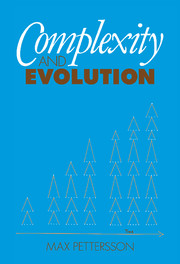Book contents
- Frontmatter
- Contents
- Foreword by Joseph Needham, FRS
- Preface
- Acknowledgements
- 1 Natural and other hierarchies
- 2 Major integrative levels
- 3 Some logarithmic forms of display
- 4 Physical range of integrated natural entities
- 5 Biological range of integrated natural entities (first part)
- 6 Biological range of integrated natural entities (second part)
- 7 Social range of integrated natural entities
- 8 Human societies (first part)
- 9 Human societies (second part)
- 10 Acceleration in evolution
- 11 Further allied accelerations
- 12 Aspects of number
- 13 Aspects of mass
- 14 Positive skewness
- 15 Quantitative conclusions
- Bibliography
- Index
10 - Acceleration in evolution
Published online by Cambridge University Press: 18 January 2010
- Frontmatter
- Contents
- Foreword by Joseph Needham, FRS
- Preface
- Acknowledgements
- 1 Natural and other hierarchies
- 2 Major integrative levels
- 3 Some logarithmic forms of display
- 4 Physical range of integrated natural entities
- 5 Biological range of integrated natural entities (first part)
- 6 Biological range of integrated natural entities (second part)
- 7 Social range of integrated natural entities
- 8 Human societies (first part)
- 9 Human societies (second part)
- 10 Acceleration in evolution
- 11 Further allied accelerations
- 12 Aspects of number
- 13 Aspects of mass
- 14 Positive skewness
- 15 Quantitative conclusions
- Bibliography
- Index
Summary
Evolution
It was in 1859 that Charles Darwin published The Origin of Species. He proposed that all existing species of animals and plants had evolved from earlier and different species; and that ‘natural selection’ had helped to produce the changes. That set the topic of evolution squarely upon the agenda. Fifty years later probably most professional biologists had come to agree with the idea, while today it is generally accepted.
Let us briefly review the ancestry of ourselves and the other mammals, aided by Fig. 2.4. Perhaps somewhere around 2000 million years ago, our ancestors became cells with nuclei; around 1000 million years ago we became multicellular organisms with internal differentiation. Then about 500 million years ago we became early vertebrates, as fish. The ‘backbone’ was however at first made of cartilage, only later of true bone. Then followed a stage as amphibians, where the adults have four legs and have lungs for the breathing of air when on land. Frogs are our best-known amphibians today. Later the tadpole stage was cut out and we became reptiles, lizards. Then some 200 million years ago some creatures started to bear their young alive and to suckle them with milk – as early mammals. This also, of course, saw the beginning of social family life, at Level 7. Careful geological and palaeontological studies have helped to establish this sequence. It has been aided by isotopic dating, as discussed in Chapter 4.
Acceleration
Fig. 2.4 gives approximate dates for the initial emergence of entities at each higher integrative level. The same information can be set out as in Fig. 10.1.
- Type
- Chapter
- Information
- Complexity and Evolution , pp. 90 - 97Publisher: Cambridge University PressPrint publication year: 1996



